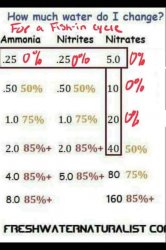Emi Leigh
New Member
- Joined
- Aug 30, 2018
- Messages
- 10
- Reaction score
- 0
Hello, I have a 5 gallon and didn't realize about the cycling process before I got my betta. I am using seachem prime and stability. I follow the image below for water changes. I started my cycle and I was using Spring water. I had ammonia and nitrate together, pretty early on which is weird. I finally got nitrites a few days ago. My nitrates went up a bit too. Checked my parameters today, as I do everyday and I have nitrites 0, ammonia .25 and nitrates at 20. I use the master test kit from API with the vials.
So this is what happened - had ammonia and nitrates for weeks. With the every other day to daily water change depending on the paremeters. Then I finally got nitrites a few days ago. Still have ammonia and nitrates but now nitrites are gone.. why? ANd what do I do now?!
So this is what happened - had ammonia and nitrates for weeks. With the every other day to daily water change depending on the paremeters. Then I finally got nitrites a few days ago. Still have ammonia and nitrates but now nitrites are gone.. why? ANd what do I do now?!




